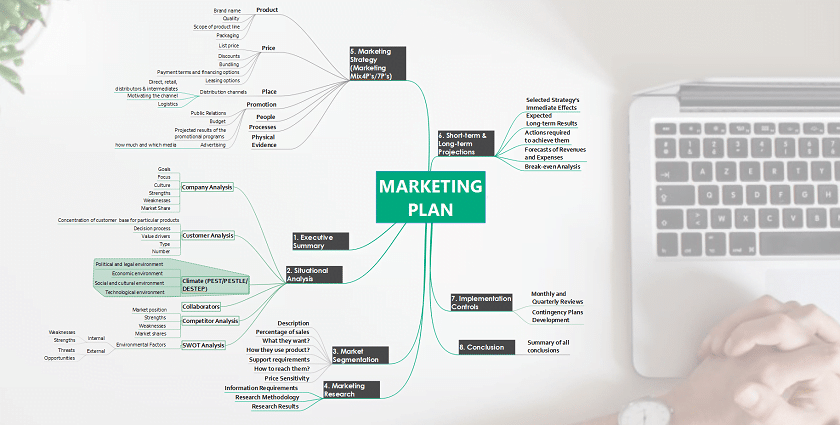With their versatility, mind maps are a tool that can be practically used in every field, by both individuals and teams. They enhance your creativity and boost your strategic thinking, bringing more organization in every plan you are working on.
Marketing is an incredibly creative and innovative field, where ideas are being generated on a daily, if not hourly, basis. They need to flow seamlessly between all members of the team, so the ideas can enter the implementation phase as soon as possible. This is where mind maps come to the rescue – they enable you and your team to clearly visualize the strategies and plan, so they can be successfully presented and comprehended by all the stakeholders involved in the process.
There are many ways in which mind maps can be integrated into marketing; from short-term ideas and plans, up to major strategies. By discovering ways in which mind maps can help you with your marketing strategy, you can successfully bring your ideas to life and bring your team’s marketing efforts to the next level.
Brainstorming
Mind maps are an excellent tool for idea generation and for both facilitating and supporting brainstorming sessions.
The best way to utilize mind maps in this process is to create a central node around the topic that needs to be discussed. It is also helpful if you follow-up with a few branches with some initial ideas, which can launch the discussion and the further brainstorming process.
Teams find it much easier when all their ideas, initiatives, and comments are being presented in a clear manner, where similar or related ideas can be connected between each other. It is also much easier for the brainstorming session organizer to later organize the ideas from the mind map and insert them into an official strategy – even though, sometimes, just sending the mind map itself is a self-explanatory report of the team’s ideas.

Mind maps are a great way for brainstorming content topics, social media topics and posts, paid advertising campaigns ideas, designs, or website content ideas. It encourages a free flow of ideas and helps identify new angles that might have been missed with a traditional approach.
If you are unsure where to start with your brainstorming mind map, check out our iMindQ template, and be all set for your next brainstorming session!
Competitor Analysis
You can also use mind maps to analyze, categorize, and organize the data about your competition. A branch can be created for each competitor, and relevant information can be added as branches about their products/services, their pricing, their markets, target audience, as well as marketing and advertising campaigns they are currently having.
Having your competitors and their marketing efforts represented visually can help you identify potential gaps in the market, and if there is a space where you can place your brand as a unique offering to a particular target audience.
Another option is to create a mind map for each of your competitors, and later add a SWOT analysis of their brand – analyze their strengths, weaknesses, opportunities, and threats, and further brainstorm on where your brand can insert itself as a better and more convenient problem solver for your audience. You can also find a SWOT Analysis mind map template here.
With a thorough competitor analysis, aided by the mind maps, you will be able to differentiate yourself from the rest of the players in your market and refine your marketing strategy and distribution channels.
Content Strategy
Every successful content strategy is not only a result of great and innovative ideas, but also of a carefully curated and implemented content strategy and action plan. If you are starting to develop a content strategy for your brand for the next period, mind maps are a great tool that can lead you through the process of developing a comprehensive content plan.
One of the ways to start generating ideas and put them into action is to divide the content into several categories: blog content, social media posts, infographics, video content, advertising content, and create a note around all of them. You can then start creating branches with various ideas on themes, topics, keywords, and headings towards which you can focus. You can later expand the mind map by adding branches for the distribution channels of each content type you’re including.
The visual overview mind maps provide a holistic approach to content marketing, providing you with a structured and aesthetic view of all the ideas, making them easy to understand and present before you start with the implementation phase.
![]()
Mapping of a Customer Journey
Determining, and later presenting the customer journey can sometimes be a complicated task. Once again, mind maps can become your indispensable tool here, assisting you show visually the complete process of bringing your customers to your product or service.
You can start by including the main stages of the customer’s journey, from awareness to conversion/purchase, and include all the necessary information throughout the process: the target customers, their preferences, and their pain points. You can later add branches on how the marketing strategy aims to solve these pain points and be with the customers throughout the entire process. Strategies for potential campaigns can be included in each of the stages.
Having the customer journey mapped out visually with the help of the mind maps helps you in creating a personalized and targeted marketing campaign, pinpointing the most important steps and processes your marketing team needs to undertake throughout your customers’ path to you.
If you need additional help on how to provide structure to your customer journey, you can check our mind map template here.
Campaign Planning
Another way to effectively utilize mind maps in marketing is for campaign planning and execution. There are two different ways you can approach campaign planning with mind maps:
- You can start with a central note which can be the campaign objective, and from there, you can add branches about the target audience, the distribution channels, the activities that are planned, as well as the expected KPIs.
- If you have already determined the distribution channels, the channel can be your central node, around which you can list the topics/campaigns, and add the KPIs for each of them.
Such a roadmap ensures that all team members will have a clear understanding of the campaign ahead and they will be aware of their roles and parts in the campaign execution, fostering team collaboration and a clear streamline of the entire process from start to finish. You can also check out our Marketing Plan mind map template and have a starting point in your planning.
Tools for Utilizing Mind Maps in Marketing
Mind maps are an incredibly dynamic and versatile tool that can offer marketers an intuitive way to bring their strategic thinking to the next level, to enhance their collaboration skills, boost their creativity, as well as to provide visualization of the ideas and efforts the team created. No matter the particular need your marketing team has at the moment, mind maps are a great way to plan and organize many aspects of their work.
One of the great digital solutions that can be used for creating, editing, and presenting mind maps is iMindQ – a mind mapping solution that provides a unique approach to visualize, organize and present ideas. It offers extensive project planning options through the several mind map options available: Mind Map, Organic Mind Map, White Board, WBS Chart, and Organizational Chart, as well as the countless templates created to give you a starting point and make you start your brainstorming and planning process immediately.
You can read more about all the available options with iMindQ here, see them for yourself by downloading a free 15-day trial, and start organizing and visualizing your ideas today!



